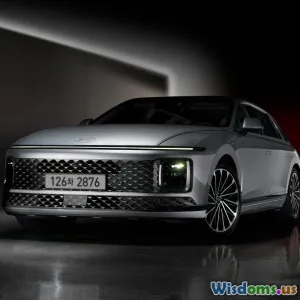
Mastering Advanced Vehicle Navigation With Smart Assistance
8 min read Explore how smart assistance elevates advanced vehicle navigation, improving safety, efficiency, and driving experience through innovative technologies and real-world applications. (0 Reviews)
Mastering Advanced Vehicle Navigation With Smart Assistance
Navigating the complex web of roads, traffic, and dynamic driving conditions has long been a challenge for drivers worldwide. But what if your vehicle could do more than simply guide you from point A to point B with maps and arrows? What if it could actively simplify driving, anticipate obstacles, and optimize your route for safety and efficiency? Welcome to the future: mastering advanced vehicle navigation with smart assistance.
This article explores the evolution of navigation systems beyond static GPS, revealing how cutting-edge technologies like AI, sensor fusion, and real-time data integration steer the way ahead. Whether you’re a tech enthusiast, automotive professional, or everyday driver, understanding these innovations can transform your approach to driving.
The Evolution of Vehicle Navigation: From Maps to Smart Assistance
The earliest vehicle navigation tools were paper maps, evolving into rudimentary GPS devices offering basic turn-by-turn guidance. While groundbreaking, these systems lacked situational awareness — they displayed routes but didn't adapt dynamically to changing conditions.
Smart assistance in navigation dramatically upgrades this paradigm by integrating several crucial features:
- Real-time traffic updates and dynamic rerouting
- Environmental sensing using cameras, LiDAR, and radar
- Integration with vehicle safety systems like collision avoidance
- Voice-activated commands and AI-driven predictive analytics
For example, Google Maps' live traffic data and Waze’s community-driven incident reports represent early smart assistance but primarily focus on route optimization. The next wave incorporates on-board sensors and AI to facilitate autonomous-like navigation support.
Core Technologies Behind Smart Navigation Assistance
1. Sensor Fusion
At the heart of advanced navigation assistance is sensor fusion — the combination of data from GPS, inertial measurement units (IMUs), cameras, radar, and LiDAR sensors. This mix allows the system to understand the vehicle’s precise location in a variety of conditions.
- GPS provides global positioning but can suffer signal blockage in urban canyons or tunnels.
- IMUs detect vehicle acceleration and orientation, supplementing position tracking.
- Cameras and LiDAR map surroundings, detect lanes, obstacles, and road signs in real-time.
Tesla’s Full Self-Driving (FSD) system exemplifies this with its multi-sensor suite enabling advanced driver assistance and semi-autonomous navigation.
2. Artificial Intelligence and Machine Learning
AI processes sensor data, predicts traffic behavior, interprets road conditions, and learns from vast amounts of driving data to improve guidance accuracy and safety.
For instance, Nvidia's Drive platform employs deep learning to recognize complex scenarios such as construction zones or sudden stops by vehicles ahead, enabling proactive advisories.
3. Connectivity and Cloud Integration
Advanced vehicle navigation leverages cloud computing for:
- Real-time traffic and weather analytics
- Live updates to maps and route optimizations
- Vehicle-to-everything (V2X) communication allowing vehicles to exchange information with infrastructure and other cars
Companies like HERE Technologies provide robust map databases and real-time sensor feeds to enhance smart navigation accuracy worldwide.
Practical Applications and Benefits of Smart Assistance in Vehicle Navigation
Enhanced Safety
Smart navigation systems monitor lanes, alert drivers of upcoming hazards, and support emergency maneuvers.
- Example: Volvo's Pilot Assist provides lane centering and adaptive cruise control, significantly reducing rear-end collisions.
- Data Insight: According to the Insurance Institute for Highway Safety (IIHS), advanced driver assistance systems can reduce crash risk by up to 40%.
Traffic and Route Optimization
Integrated real-time data allow dynamic rerouting and efficient navigation.
- Example: Waze, owned by Google, utilizes crowdsourced data to reroute drivers away from traffic jams or accidents, shaving minutes off travel times.
- Statistic: Studies show that such optimized routing can reduce overall fuel consumption by approximately 10%, contributing to environmental sustainability.
Support for Autonomous and Semi-Autonomous Driving
Advanced navigation assistance systems lay the groundwork for full autonomy by managing complex driving scenarios.
- Example: Waymo's autonomous vehicles combine smart navigation assistance with AI to safely navigate urban environments.
Driver Convenience and Reduced Cognitive Load
Voice-controlled navigation, predictive route suggestions, and integration with personal calendars or preferences enhance the user experience.
- Example: Tesla's voice command system can plot routes based on driver habits or current conditions without manual input.
Challenges and Future Directions
Addressing Data Privacy and Security
With vehicles increasingly connected, safeguarding driver data is critical. Manufacturers are developing robust encryption and privacy policies to protect sensitive information from cyber threats.
Navigating Complex Environments
Dense urban areas with unpredictable events and low GPS signal demand continual advancements in sensor precision and AI algorithms.
Expanding Vehicle-to-Everything (V2X) Infrastructure
Broader adoption of V2X communication promises significant safety and efficiency improvements, requiring governmental and private sector collaboration.
Emerging Technologies to Watch
- 5G Connectivity: Ultra-low latency networks will enable faster vehicle response and data exchange.
- Augmented Reality (AR) HUDs: Projects like Audi's AR heads-up display aim to project navigation cues directly onto the windshield, enhancing situational awareness.
- Edge Computing: Processing data locally within the vehicle reduces delay and dependence on network connectivity.
Conclusion: Mastering Smart Navigation
Advanced vehicle navigation with smart assistance is not just a convenience — it’s a transformative shift toward safer, more efficient, and enjoyable driving experiences. By integrating sophisticated sensors, AI, real-time connectivity, and human-centric design, these systems empower drivers to confidently adapt to complex road environments.
As these technologies mature and become more accessible, every driver stands to benefit from smarter guidance and proactive safety management. Embracing this future requires an understanding of the underlying tools and their potential — making mastery of smart navigation assistance not only relevant but essential in today's automotive landscape.
Whether you are selecting a new vehicle equipped with advanced navigation features or exploring aftermarket systems, knowing how smart assistance enhances navigation equips you for a safer, more informed journey ahead.
“The future of driving is not just about getting there — it’s about driving smarter, safer, and more connected.” — Dr. Helena Kwon, Automotive AI Specialist
Rate the Post
User Reviews
Popular Posts




















